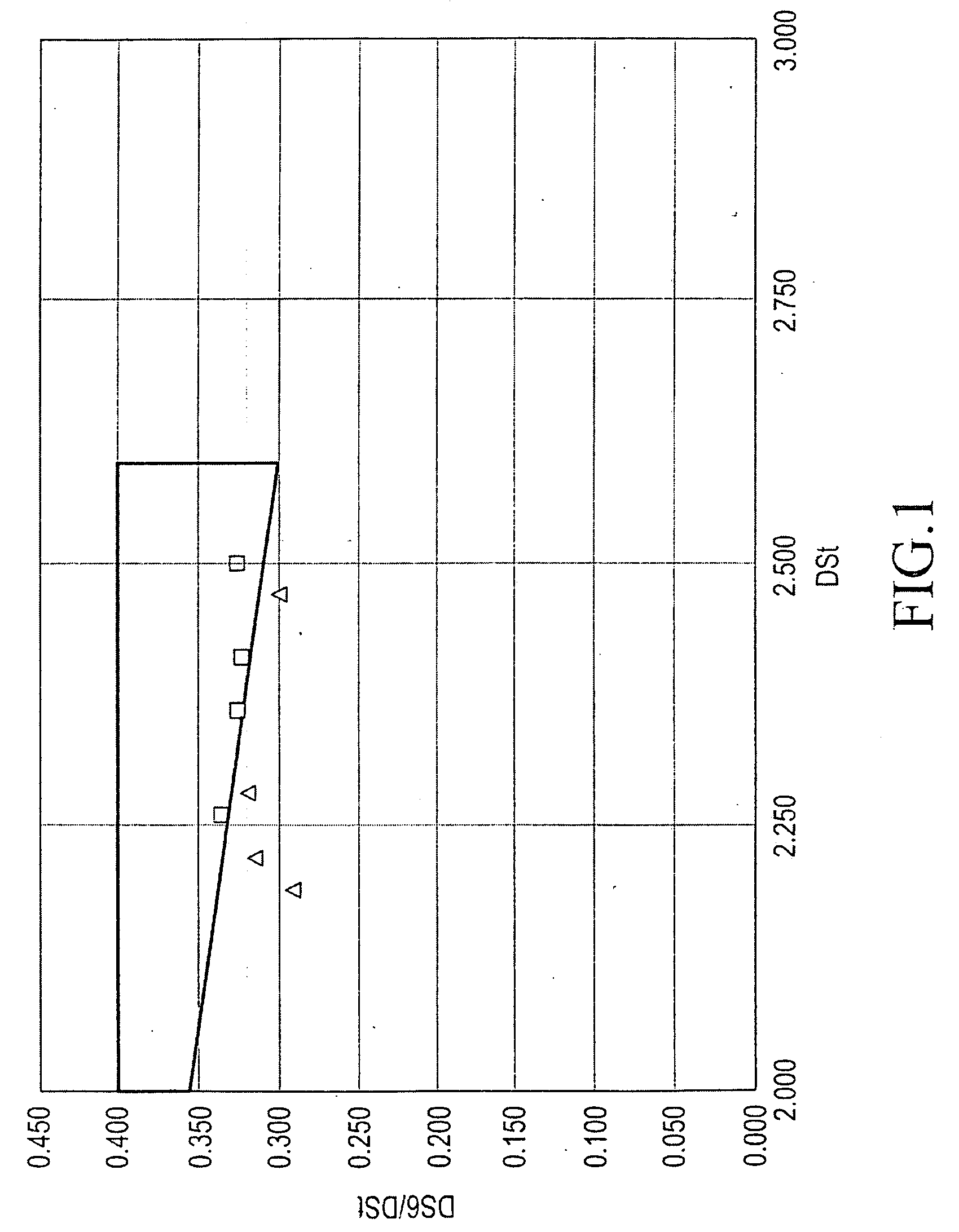6-position highly acetylated cellulose diacetate and process for producing the same
- Summary
- Abstract
- Description
- Claims
- Application Information
AI Technical Summary
Benefits of technology
Problems solved by technology
Method used
Image
Examples
example 1
[0103]A sheet-like cellulose (softwood pulp) was refined into a flocculent cellulose with a disk refiner. To 100 g of the flocculent cellulose (with a water content of 8.0 percent by weight) was sprayed 32.71 g of acetic acid, and the mixture was thoroughly stirred and then left stand at a temperature of 24° C. for 60 minutes (activation step). The activated cellulose was combined with 348.98 g of acetic acid, 290.90 g of acetic anhydride, and 11.24 g of sulfuric acid, the mixture was held at 15° C. for 20 minutes, raised in temperature at a rate of 0.31° C. per minute to 45° C., held at the temperature for 70 minutes to carry out acetylation, and thereby yielded a cellulose triacetate. Next, the acetylation reaction was terminated by adding 0.19 g of acetic acid, 78.08 g of water, and 9.27 g of magnesium acetate.
[0104]The resulting reaction mixture was combined with 0.02 g of acetic acid, 2.86 g of water, and 0.91 g of magnesium acetate, followed by a ripening reaction at 75° C. fo...
example 2
[0106]A sheet-like cellulose (softwood pulp) was refined into a flocculent cellulose with a disk refiner. To 100 g of the flocculent cellulose (with a water content of 8.0 percent by weight) was sprayed 32.71 g of acetic acid, and the mixture was thoroughly stirred and then left stand at a temperature of 24° C. for 60 minutes (activation step). The activated cellulose was combined with 340.91 g of acetic acid, 297.76 g of acetic anhydride, and 11.24 g of sulfuric acid, the mixture was held at 15° C. for 20 minutes, raised in temperature at a rate of 0.31° C. per minute to 45° C., held at the temperature for 70 minutes to carry out acetylation, and thereby yielded a cellulose triacetate. Next, the acetylation reaction was terminated by adding 0.19 g of acetic acid, 78.08 g of water, and 9.27 g of magnesium acetate.
[0107]The resulting reaction mixture was combined with 0.02 g of acetic acid, 2.86 g of water, and 0.91 g of magnesium acetate, followed by a ripening reaction at 75° C. fo...
example 3
[0109]A sheet-like cellulose (softwood pulp) was refined into a flocculent cellulose with a disk refiner. To 100 g of the flocculent cellulose (with a water content of 8.0 percent by weight) was sprayed 32.71 g of acetic acid, and the mixture was thoroughly stirred and then left stand at a temperature of 24° C. for 60 minutes (activation step). The activated cellulose was combined with 340.91 g of acetic acid, 297.76 g of acetic anhydride, and 10.22 g of sulfuric acid, the mixture was held at 15° C. for 20 minutes, raised in temperature at a rate of 0.31° C. per minute to 45° C., held at the temperature for 70 minutes to carry out acetylation, and thereby yielded a cellulose triacetate. Next, the acetylation reaction was terminated by adding 0.16 g of acetic acid, 68.59 g of water, and 7.80 g of magnesium acetate.
[0110]The resulting reaction mixture was combined with 0.02 g of acetic acid, 2.86 g of water, and 0.91 g of magnesium acetate, followed by a ripening reaction at 72° C. fo...
PUM
| Property | Measurement | Unit |
|---|---|---|
| Temperature | aaaaa | aaaaa |
| Temperature | aaaaa | aaaaa |
| Percent by mass | aaaaa | aaaaa |
Abstract
Description
Claims
Application Information
 Login to View More
Login to View More - R&D
- Intellectual Property
- Life Sciences
- Materials
- Tech Scout
- Unparalleled Data Quality
- Higher Quality Content
- 60% Fewer Hallucinations
Browse by: Latest US Patents, China's latest patents, Technical Efficacy Thesaurus, Application Domain, Technology Topic, Popular Technical Reports.
© 2025 PatSnap. All rights reserved.Legal|Privacy policy|Modern Slavery Act Transparency Statement|Sitemap|About US| Contact US: help@patsnap.com

